Nicole schreibt...
China 2016 |
 |
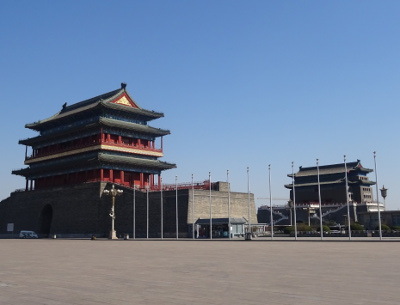 Having visited almost all countries in South East Asia I had been curious about (even though I know I'll need to go back to see a lot more!) I decided it was about time that I tackled the big neighbour up north, China. The People's Republic has not only dominated the economy section of the media in recent years but also opened up to foreign tourism. However, had I known that they still require people to get a visa and that said visa would set me back 126 Euro, I might have changed my mind. At least flights were surprisingly cheap, so I was off to Beijing via Frankfurt on Lufthansa now.
Things went fine with immigration being swift (take note, JFK!) and a honest taxi driver taking me from the airport to the cheap hostel I had booked just south of Tiananmen Square and the Forbidden City within the sight of Qianmen Gate - which was once part of the border between the Manchu Forbidden City area and the Chinese village beyond. These days it's turning into a nice backpacker area with pedestrianised Qianmen Street and Dashilar Street, both refurbished to ressemble the "old Beijing" with its traditional shops, street kitchen and plush restaurants serving up Peking Duck.
Having visited almost all countries in South East Asia I had been curious about (even though I know I'll need to go back to see a lot more!) I decided it was about time that I tackled the big neighbour up north, China. The People's Republic has not only dominated the economy section of the media in recent years but also opened up to foreign tourism. However, had I known that they still require people to get a visa and that said visa would set me back 126 Euro, I might have changed my mind. At least flights were surprisingly cheap, so I was off to Beijing via Frankfurt on Lufthansa now.
Things went fine with immigration being swift (take note, JFK!) and a honest taxi driver taking me from the airport to the cheap hostel I had booked just south of Tiananmen Square and the Forbidden City within the sight of Qianmen Gate - which was once part of the border between the Manchu Forbidden City area and the Chinese village beyond. These days it's turning into a nice backpacker area with pedestrianised Qianmen Street and Dashilar Street, both refurbished to ressemble the "old Beijing" with its traditional shops, street kitchen and plush restaurants serving up Peking Duck.
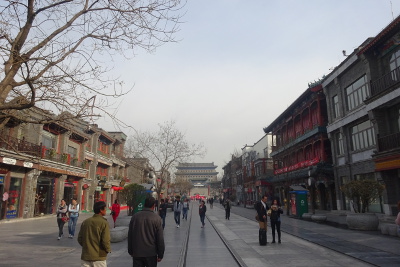
|
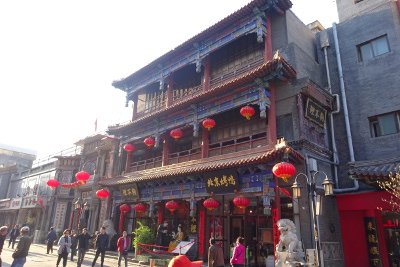 |
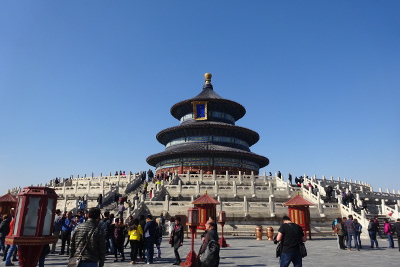
|
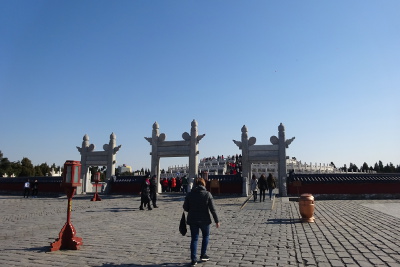 |
 After a good first night, it was time for the first biggie: The Forbidden City, home of the Chinese emperors and a sprawling complex of (supposedly) 9999 rooms. The way there leads across the vast Tiananmen Square, best-known in the west now as the site of the tragic events of 1989 when the government massacred hundreds of students and workers demonstrating for more democracy and freedom.
The "Gate of Heavenly Peace" once marked the first entrance to the Imperial City and it was here where Mao Zedong proclaimed the People's Republic to the masses on the square, so ever since his portray has graced the facade.
Once through, you continue on to the Meridian Gate (1), which formed the actual entrance to the Forbidden City and THEN you stand in the first vast forecourt with its four bridges across the Golden Water to proceed to the Gate of Surpreme Harmony (2) and into the next, even bigger forecourt which leads to the Hall of Surpreme Harmony (3), the first of the three official reception buildings where the emperors held court (4):
After a good first night, it was time for the first biggie: The Forbidden City, home of the Chinese emperors and a sprawling complex of (supposedly) 9999 rooms. The way there leads across the vast Tiananmen Square, best-known in the west now as the site of the tragic events of 1989 when the government massacred hundreds of students and workers demonstrating for more democracy and freedom.
The "Gate of Heavenly Peace" once marked the first entrance to the Imperial City and it was here where Mao Zedong proclaimed the People's Republic to the masses on the square, so ever since his portray has graced the facade.
Once through, you continue on to the Meridian Gate (1), which formed the actual entrance to the Forbidden City and THEN you stand in the first vast forecourt with its four bridges across the Golden Water to proceed to the Gate of Surpreme Harmony (2) and into the next, even bigger forecourt which leads to the Hall of Surpreme Harmony (3), the first of the three official reception buildings where the emperors held court (4):
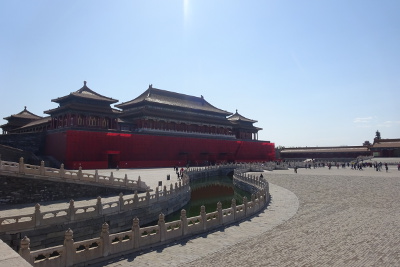
|
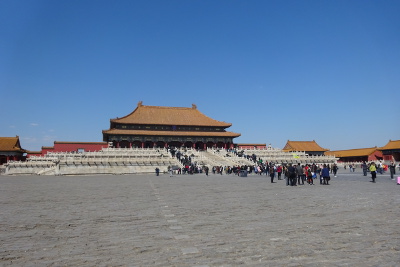 |
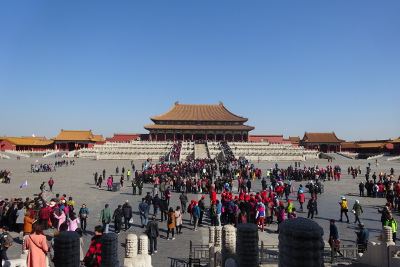
|
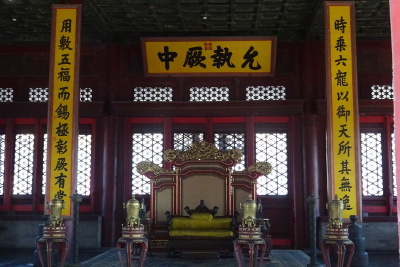 |
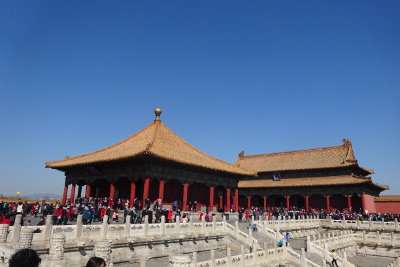 The other two being the Hall of Middle Harmony and the Hall of Protecting Harmony (see right). The crush of the tour groups, which were shepherded straight along the south-north axis of the main buildings was rather insane here, but skip to the western or eastern areas of the Forbidden City and you were almost alone. Oh sweet relief.
But for the sake of this narrative, we'll continue on the main path here, stepping through the Gate of Heavenly Purity into the inner sanctum of the emperors, another three halls following in swift succession, starting with the Hall of Heavenly Purity (below left) and the Palace of Earthly Tranquility (right), before reaching the beautiful Imperial Gardens and the northern exit where most of the tour groups luckily depart.
The other two being the Hall of Middle Harmony and the Hall of Protecting Harmony (see right). The crush of the tour groups, which were shepherded straight along the south-north axis of the main buildings was rather insane here, but skip to the western or eastern areas of the Forbidden City and you were almost alone. Oh sweet relief.
But for the sake of this narrative, we'll continue on the main path here, stepping through the Gate of Heavenly Purity into the inner sanctum of the emperors, another three halls following in swift succession, starting with the Hall of Heavenly Purity (below left) and the Palace of Earthly Tranquility (right), before reaching the beautiful Imperial Gardens and the northern exit where most of the tour groups luckily depart.

|
 |
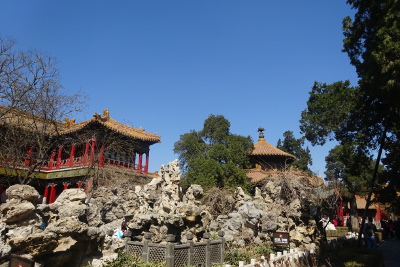
|
 |
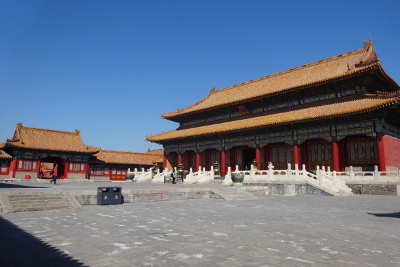
|
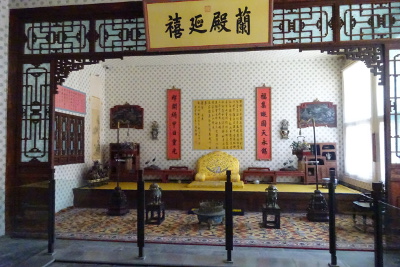 |
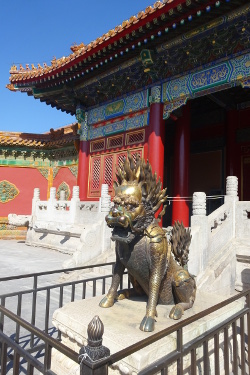 |
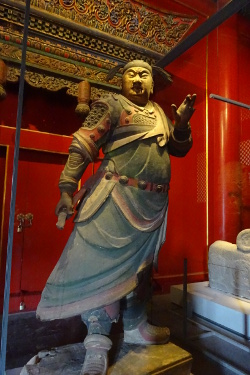 |
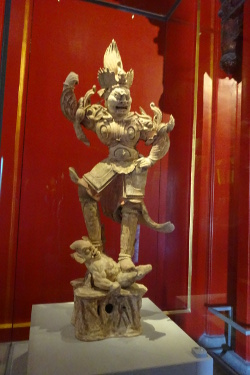 |
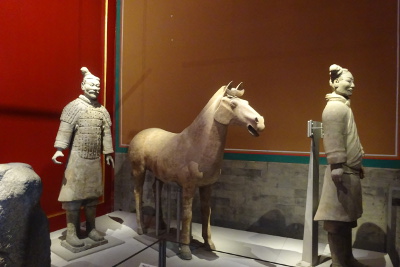
|
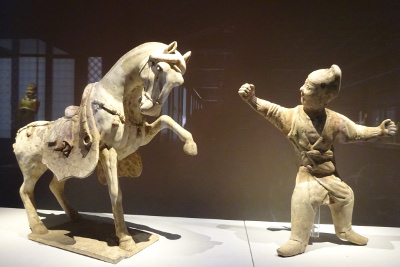 |
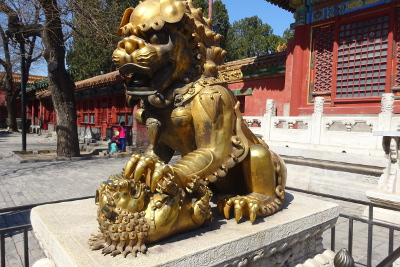 Finally we move east to another section with the Treasure Gallery, the Opera and the amazing Nine Dragon Screen. There was also a classical orchestra consisting of a whole bunch of bronze bells and strangely shaped stone slabs that went ping and ding apparently. Finally there was a whole insane collection of crazy clocks which the Europeans made for the emperors who were apparently fascinated by clockwork and collected these showpieces.
Finally we move east to another section with the Treasure Gallery, the Opera and the amazing Nine Dragon Screen. There was also a classical orchestra consisting of a whole bunch of bronze bells and strangely shaped stone slabs that went ping and ding apparently. Finally there was a whole insane collection of crazy clocks which the Europeans made for the emperors who were apparently fascinated by clockwork and collected these showpieces.
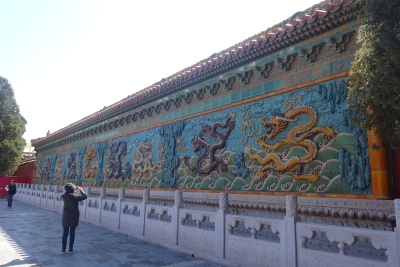
|
 |
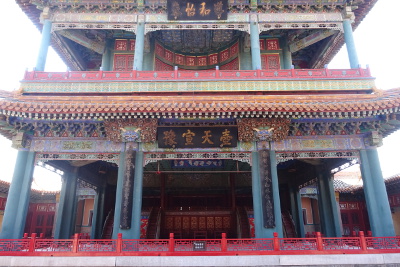
|
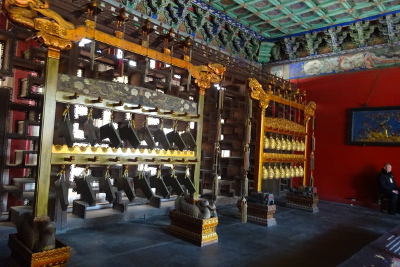 |
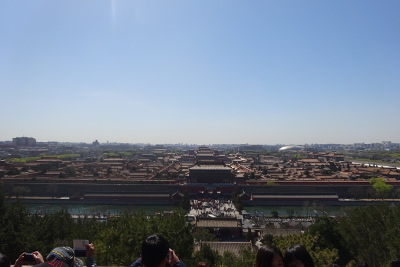 All in all I spent about five hours in the Forbidden City and I do think you should a) plan an entire day for it and b) make sure to go there alone and not as part of a tour group, so you can explore all the nooks and crannies at your own leisure. Luckily there are plenty of toilets as well as kiosks to buy drinks from, a proper restaurant and more souvenir shops than you shake a guide book at.
And make sure you have enough time or breath left to climb up Jingshan Hill, that was created by the earth removed for the palace moat, just beyond the northern exit. These days it offers a splendid view all over the Forbidden City and most of Beijing (at least when you're lucky and get a day when the city isn't choking on its smog).
All in all I spent about five hours in the Forbidden City and I do think you should a) plan an entire day for it and b) make sure to go there alone and not as part of a tour group, so you can explore all the nooks and crannies at your own leisure. Luckily there are plenty of toilets as well as kiosks to buy drinks from, a proper restaurant and more souvenir shops than you shake a guide book at.
And make sure you have enough time or breath left to climb up Jingshan Hill, that was created by the earth removed for the palace moat, just beyond the northern exit. These days it offers a splendid view all over the Forbidden City and most of Beijing (at least when you're lucky and get a day when the city isn't choking on its smog).
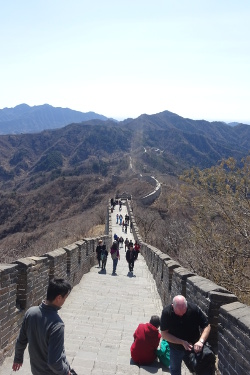 |
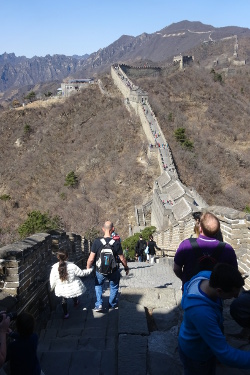 |
|
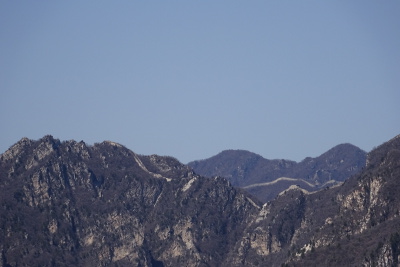
|
|
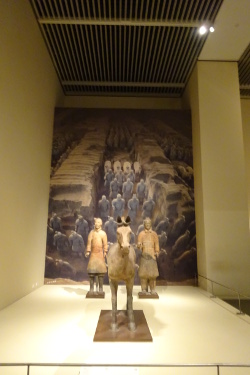 |
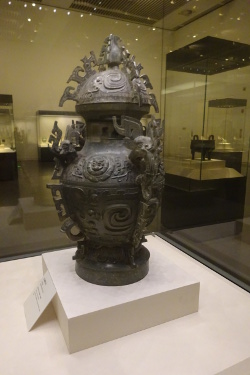 |
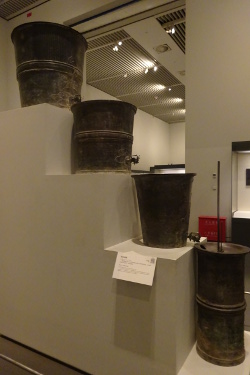 |
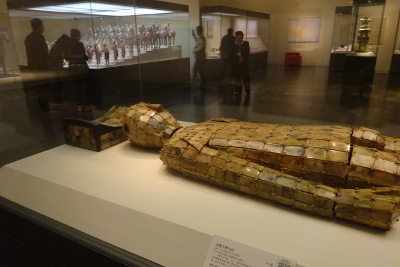
|
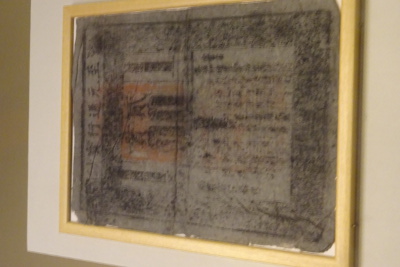 |
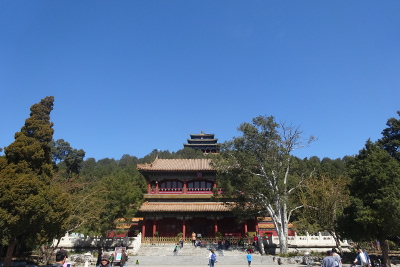 I walked along the length of the Forbidden City then to Jingshan Hill (right) and on to Beihai Park, where the locals were out in force to enjoy the spring sunshine and go boating on the huge lake. Where now the white Dagoba pagoda rises was once supposedly the first palace of Kublai Khan, grandson of Jenghis, who had conquered the area for his Greater Mongolia empire.
After some people watching in the park and trying the ubiquitous Beijing snack, candied hawthorn, I walked on to the Bell and Drum Towers nearby, that were used as Beijing's official timekeepers from medieval days until 1924. The bell is over 600 years old and weighs an impressive 63 tonnes! Then my sightseeing for the day was done and I walked along nice Guloudong Street with its busy shops and cafes to a metro stop to go "home" to Qianmen and find a lovely Chinese massage.
I walked along the length of the Forbidden City then to Jingshan Hill (right) and on to Beihai Park, where the locals were out in force to enjoy the spring sunshine and go boating on the huge lake. Where now the white Dagoba pagoda rises was once supposedly the first palace of Kublai Khan, grandson of Jenghis, who had conquered the area for his Greater Mongolia empire.
After some people watching in the park and trying the ubiquitous Beijing snack, candied hawthorn, I walked on to the Bell and Drum Towers nearby, that were used as Beijing's official timekeepers from medieval days until 1924. The bell is over 600 years old and weighs an impressive 63 tonnes! Then my sightseeing for the day was done and I walked along nice Guloudong Street with its busy shops and cafes to a metro stop to go "home" to Qianmen and find a lovely Chinese massage.
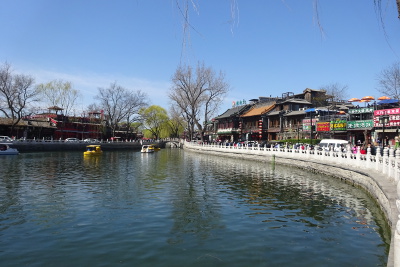
|
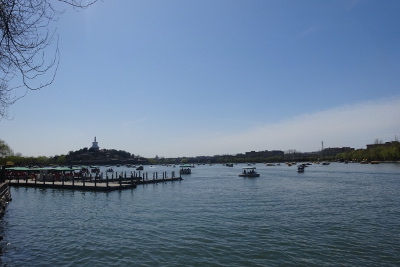 |
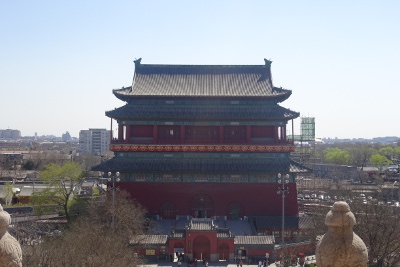
|
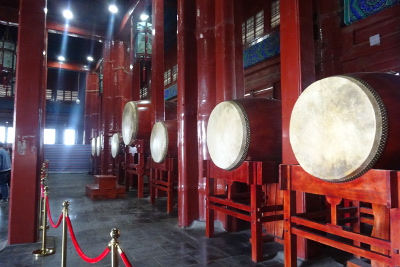 |
 |
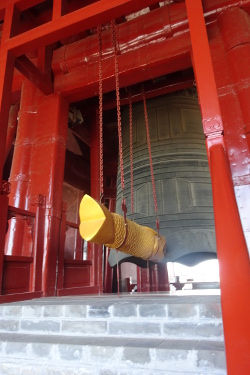 |
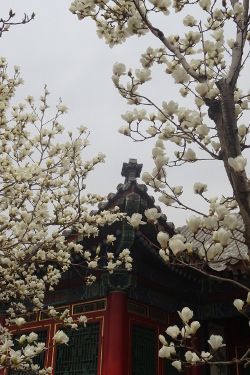 |
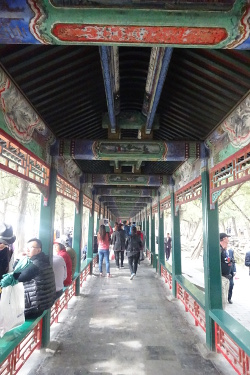 My last day in Beijing took me by metro (for all of $0.80!) to the outskirts of the city to the old Summer Palace by Kunming Lake which Emperor Qianlong had built in 18th century. Many of the gorgeous old buildings were ruined by rampaging British and French troops in 1860 after the end of the second Opium War, then rebuilt by Empress Cixi only to be destroyed again in the boxer uprising of 1900. It was rebuilt again after WWII (by the communists no less!) and still looks rather fresh and pretty. While the gorgeous sunshine had come to an end, it had awakened trees and shrubs to bloom and it made for an absolutely lovely walk around the lake.
Star attractions are Longevity Hill with a bunch of beautiful halls and temples climbing up the hill, the crazy "long corridor" (left) that goes on for 700 metres and enabled the emperors to stroll along the lakeshore even when it rained and the gorgeous bridge leading to Dragon King Island with its temple. But really, it was just the lake itself, the trees in bloom and the whole atmosphere that made this outing an absolute joy:
My last day in Beijing took me by metro (for all of $0.80!) to the outskirts of the city to the old Summer Palace by Kunming Lake which Emperor Qianlong had built in 18th century. Many of the gorgeous old buildings were ruined by rampaging British and French troops in 1860 after the end of the second Opium War, then rebuilt by Empress Cixi only to be destroyed again in the boxer uprising of 1900. It was rebuilt again after WWII (by the communists no less!) and still looks rather fresh and pretty. While the gorgeous sunshine had come to an end, it had awakened trees and shrubs to bloom and it made for an absolutely lovely walk around the lake.
Star attractions are Longevity Hill with a bunch of beautiful halls and temples climbing up the hill, the crazy "long corridor" (left) that goes on for 700 metres and enabled the emperors to stroll along the lakeshore even when it rained and the gorgeous bridge leading to Dragon King Island with its temple. But really, it was just the lake itself, the trees in bloom and the whole atmosphere that made this outing an absolute joy:
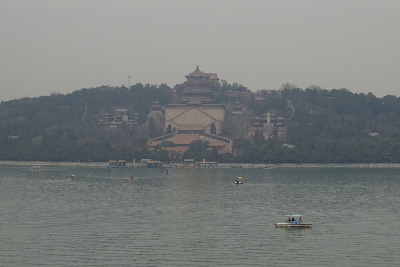
|
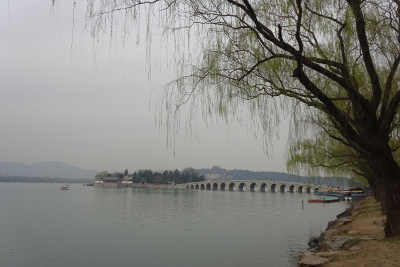 |
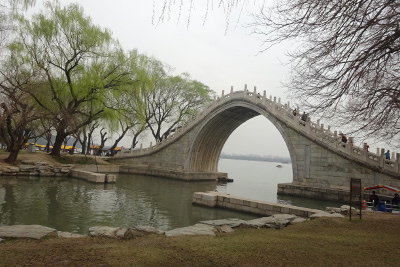
|
 |
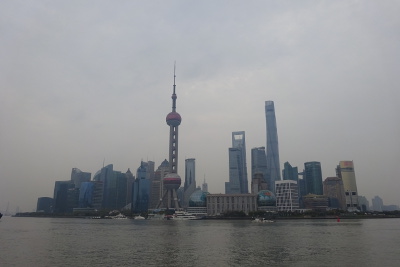 Next morning I was off to Shanghai on the "new" highspeed trains that need only five hours to cover the nearly thousand kilometres. The trains in question being German ICE3 trains that really get a chance to stretch their legs in China (unlike here). While the seating was different, much of the layout and the potties were exactly the same as on the German ICEs which was rather amusing.
We trundled into Shanghai Hongqiao Station, which is shiny-new and apparently the biggest train station in all of Asia, then I continued onwards on the Shanghai Metro to my hotel by the Bund. Having cheapskated in Beijing by booking a simple hostel, I had allowed myself some luxury in Shanghai now by booking the Astor House Hotel which was the very first Western hotel to open in Shanghai in 1846 after the Europeans got their concession to use the place as a trading port. It still breathes colonial atmosphere in every nook and cranny and was just a fabulous place to stay in.
Next morning I was off to Shanghai on the "new" highspeed trains that need only five hours to cover the nearly thousand kilometres. The trains in question being German ICE3 trains that really get a chance to stretch their legs in China (unlike here). While the seating was different, much of the layout and the potties were exactly the same as on the German ICEs which was rather amusing.
We trundled into Shanghai Hongqiao Station, which is shiny-new and apparently the biggest train station in all of Asia, then I continued onwards on the Shanghai Metro to my hotel by the Bund. Having cheapskated in Beijing by booking a simple hostel, I had allowed myself some luxury in Shanghai now by booking the Astor House Hotel which was the very first Western hotel to open in Shanghai in 1846 after the Europeans got their concession to use the place as a trading port. It still breathes colonial atmosphere in every nook and cranny and was just a fabulous place to stay in.
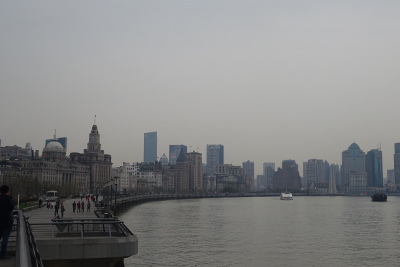 I soon headed out again though for a first walk along the Bund to look at the amazing skyline of Pudong with its skyscrapers that have shot up within a short span of time across the river, including the crazy architecture of the Oriental Pearl TV Tower (the one with the round "balls").
The Bund meanwhile was were the Europeans set up shop in late 19th and early 20th century and got filthy rich (mostly on the opium trade). The city I was most reminded of was New York though, with a similar mix of beautiful old architecture, drab late-20th-century concrete and modern skyscrapers. I turned into the main shopping street East Nanjing Road to find dinner, then went to explore Shanghai properly the next day.
First destination after the long walk along the Bund was the Old Town with the Yuyuan Gardens, all beautifully (albeit a little artifically) restored with lots of souvenir shops, the Temple of the City God and the incredible gardens, an oasis of tranquility in the middle of this huge buzzing town.
I soon headed out again though for a first walk along the Bund to look at the amazing skyline of Pudong with its skyscrapers that have shot up within a short span of time across the river, including the crazy architecture of the Oriental Pearl TV Tower (the one with the round "balls").
The Bund meanwhile was were the Europeans set up shop in late 19th and early 20th century and got filthy rich (mostly on the opium trade). The city I was most reminded of was New York though, with a similar mix of beautiful old architecture, drab late-20th-century concrete and modern skyscrapers. I turned into the main shopping street East Nanjing Road to find dinner, then went to explore Shanghai properly the next day.
First destination after the long walk along the Bund was the Old Town with the Yuyuan Gardens, all beautifully (albeit a little artifically) restored with lots of souvenir shops, the Temple of the City God and the incredible gardens, an oasis of tranquility in the middle of this huge buzzing town.

|
 |
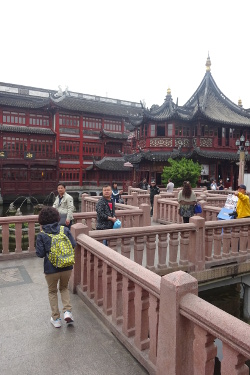 |
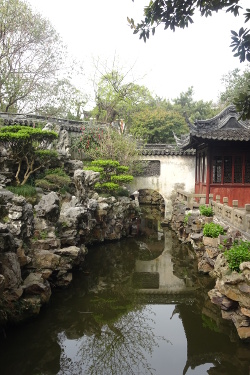 |
 |
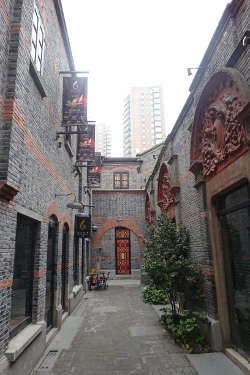 It wasn't much further to walk from the Old Town to the (former) French Concession, which is now apparently the "happening" area of the town with upmarket designer brands lining Huahai Street, little trendy boutiques and cafes. Once they got hold of their trading licenses, the Brits and French divvied up Shanghai (no more than a small fishing town at the time) between themselves with a creek forming the border. For some reason, at least for foreigners, the area name "French Concession" has stuck until today.
My destination was Xintiandi (right), which is one of the last remaining areas in Shanghai were the old "shikumen" (stone houses) were kept and restored. With their mix of European and Chinese architecture they had sprung up all over Shanghai around the turn of the century when the young town was growing, but have now mostly been replaced by modern apartment buildings. Xintiandi has now been turned into a generic hipster hangout with shops, cafes and bars that look the same all over the world, but the architecture is still worth seeing.
At least it came with an ubiquitous Starbucks, where I paused for a while before returning through the People's Park (once the racecourse of the Europeans) and down East Nanjing Road back to the hotel for a longer break.
It wasn't much further to walk from the Old Town to the (former) French Concession, which is now apparently the "happening" area of the town with upmarket designer brands lining Huahai Street, little trendy boutiques and cafes. Once they got hold of their trading licenses, the Brits and French divvied up Shanghai (no more than a small fishing town at the time) between themselves with a creek forming the border. For some reason, at least for foreigners, the area name "French Concession" has stuck until today.
My destination was Xintiandi (right), which is one of the last remaining areas in Shanghai were the old "shikumen" (stone houses) were kept and restored. With their mix of European and Chinese architecture they had sprung up all over Shanghai around the turn of the century when the young town was growing, but have now mostly been replaced by modern apartment buildings. Xintiandi has now been turned into a generic hipster hangout with shops, cafes and bars that look the same all over the world, but the architecture is still worth seeing.
At least it came with an ubiquitous Starbucks, where I paused for a while before returning through the People's Park (once the racecourse of the Europeans) and down East Nanjing Road back to the hotel for a longer break.

|
 |
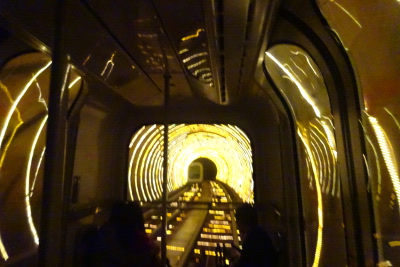 Later on it was time to cross the river to Pudong - with little choice but the naff Bund Sightseeing Tunnel nearby. Basically you roll in little automatic cars underneath the river accompanied by frenzied lighting effects. It's overpriced and daft, but also the only direct connection unless you want to walk for ages to use the metro or the ferry downriver.Here's the beginning of it and it gets only sillier after that.
My destination was actually the Oriental Pearl TV Tower, though not to pay a fortune to go up to the observation deck (it was too smoggy anyway to see much) but to visit the Shanghai History Museum in the basement which was full of gorgeous dioramas of Old Shanghai:
Later on it was time to cross the river to Pudong - with little choice but the naff Bund Sightseeing Tunnel nearby. Basically you roll in little automatic cars underneath the river accompanied by frenzied lighting effects. It's overpriced and daft, but also the only direct connection unless you want to walk for ages to use the metro or the ferry downriver.Here's the beginning of it and it gets only sillier after that.
My destination was actually the Oriental Pearl TV Tower, though not to pay a fortune to go up to the observation deck (it was too smoggy anyway to see much) but to visit the Shanghai History Museum in the basement which was full of gorgeous dioramas of Old Shanghai:
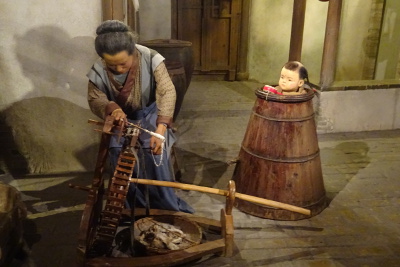
|
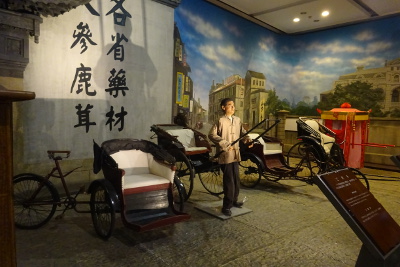 |
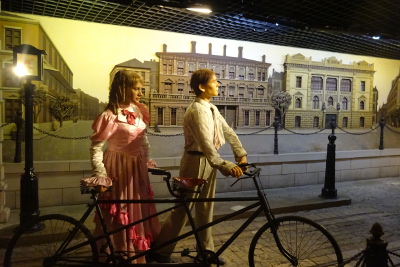
|
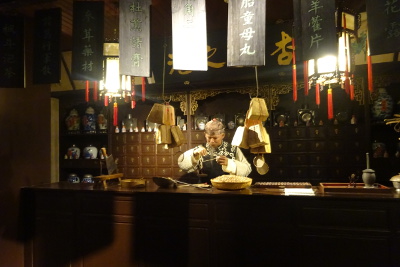 |
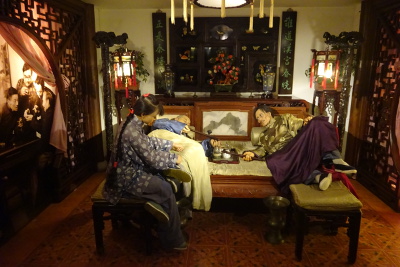
|
 |
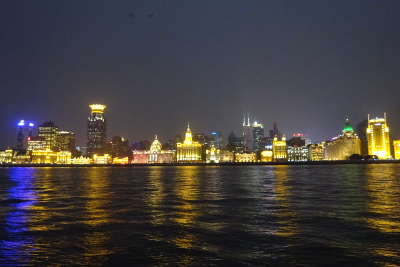 I moved to a big new mall from there for dinner, then to the riverside to admire the gorgeous panorama of the Bund by night, before returning to my side of the Huangpu (again via the silly tunnel).
My last day in China should have been another highlight, the famous Gardens of Suzhou, a World Heritage Site in what was once "The Venice of the East" and the most important town in the area before Shanghai rose to fame. It's only 30 mins by train to get there, but to some extent sightseeing fatigue had set in, I had already seen other gardens and the most famous one, the "Humble Administrator's Garden" was so crowded with groups that there was no question of tranquility or serenity. I still did get some nice pictures out of it anyway.
I moved to a big new mall from there for dinner, then to the riverside to admire the gorgeous panorama of the Bund by night, before returning to my side of the Huangpu (again via the silly tunnel).
My last day in China should have been another highlight, the famous Gardens of Suzhou, a World Heritage Site in what was once "The Venice of the East" and the most important town in the area before Shanghai rose to fame. It's only 30 mins by train to get there, but to some extent sightseeing fatigue had set in, I had already seen other gardens and the most famous one, the "Humble Administrator's Garden" was so crowded with groups that there was no question of tranquility or serenity. I still did get some nice pictures out of it anyway.
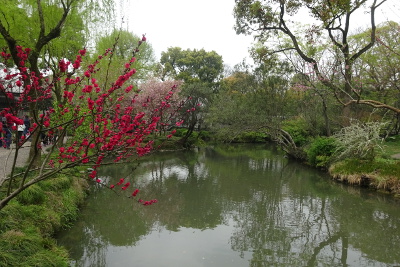
|
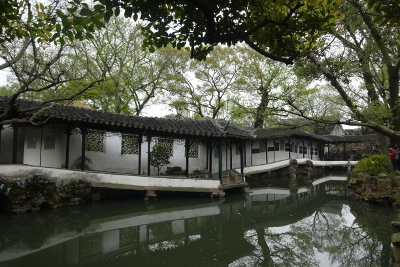 |
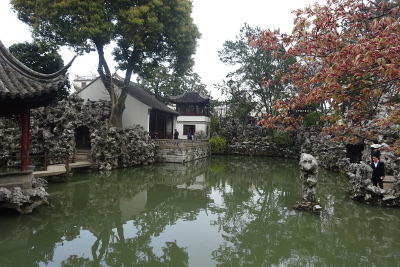
|
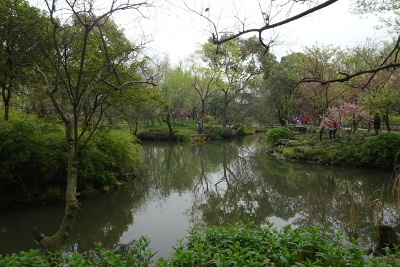 |
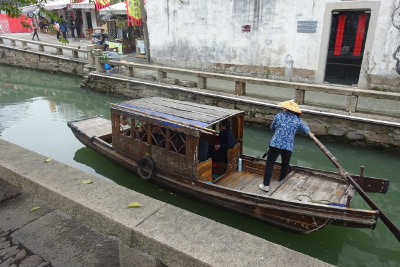 Suzhou has a total of four famous gardens (called yuanlin) and a couple of smaller ones, that were created during the Ming and Qing dynasties by rich intellectuals as their personal chill-out spaces with lovely little pavillions and halls. But after I had strolled around the Lion Forest Garden as well, I decided that two were really quite enough for the day.
I wandered the length of Pingjiang Lu, one of the best-maintained old canals that is now lined with touristy little shops and restaurants before returning to the huge new railway station north of the old town, which was a great example of how pleasant and easy to navigate a railway station can be when built new from scratch. Then I returned to Shanghai for one last evening stroll along the Bund and East Nanjing Road before it was time to say goodbye to China next morning.
Suzhou has a total of four famous gardens (called yuanlin) and a couple of smaller ones, that were created during the Ming and Qing dynasties by rich intellectuals as their personal chill-out spaces with lovely little pavillions and halls. But after I had strolled around the Lion Forest Garden as well, I decided that two were really quite enough for the day.
I wandered the length of Pingjiang Lu, one of the best-maintained old canals that is now lined with touristy little shops and restaurants before returning to the huge new railway station north of the old town, which was a great example of how pleasant and easy to navigate a railway station can be when built new from scratch. Then I returned to Shanghai for one last evening stroll along the Bund and East Nanjing Road before it was time to say goodbye to China next morning.
 It turned into a day of disappointments with the much vaunted Maglev super-high-speed-train between the city and Pudong Airport (which once started life as the Transrapid in Germany before being sold to China) not going faster than 300 km/h and Swiss Airlines making a joke of Swiss punctuality by being four hours late (and me missing my connection to Cologne in Zürich). Oh well, at least the bad stuff waited until the very last to happen.
China definitely felt more like a challenge than South East Asia, which is far more geared towards western tourists, whereas China seems content to support itself with domestic tourism (and why not, there's a billion potential customers!). Yet with all the media hype around China, it was interesting to not just see the amazing historical places like the Forbidden City and the Wall, but also modern China with all its good sides such as great modern transport everywhere and the bad sides such as the terrible pollution or the immense police presence around Tiananmen Square. While there are plenty of cities that make me feel I could live there for a while such as Dubai or Singapore, I couldn't say the same for China. Visiting as a tourist for two weeks though? Definitely!
It turned into a day of disappointments with the much vaunted Maglev super-high-speed-train between the city and Pudong Airport (which once started life as the Transrapid in Germany before being sold to China) not going faster than 300 km/h and Swiss Airlines making a joke of Swiss punctuality by being four hours late (and me missing my connection to Cologne in Zürich). Oh well, at least the bad stuff waited until the very last to happen.
China definitely felt more like a challenge than South East Asia, which is far more geared towards western tourists, whereas China seems content to support itself with domestic tourism (and why not, there's a billion potential customers!). Yet with all the media hype around China, it was interesting to not just see the amazing historical places like the Forbidden City and the Wall, but also modern China with all its good sides such as great modern transport everywhere and the bad sides such as the terrible pollution or the immense police presence around Tiananmen Square. While there are plenty of cities that make me feel I could live there for a while such as Dubai or Singapore, I couldn't say the same for China. Visiting as a tourist for two weeks though? Definitely!
Copyright © All Rights Reserved